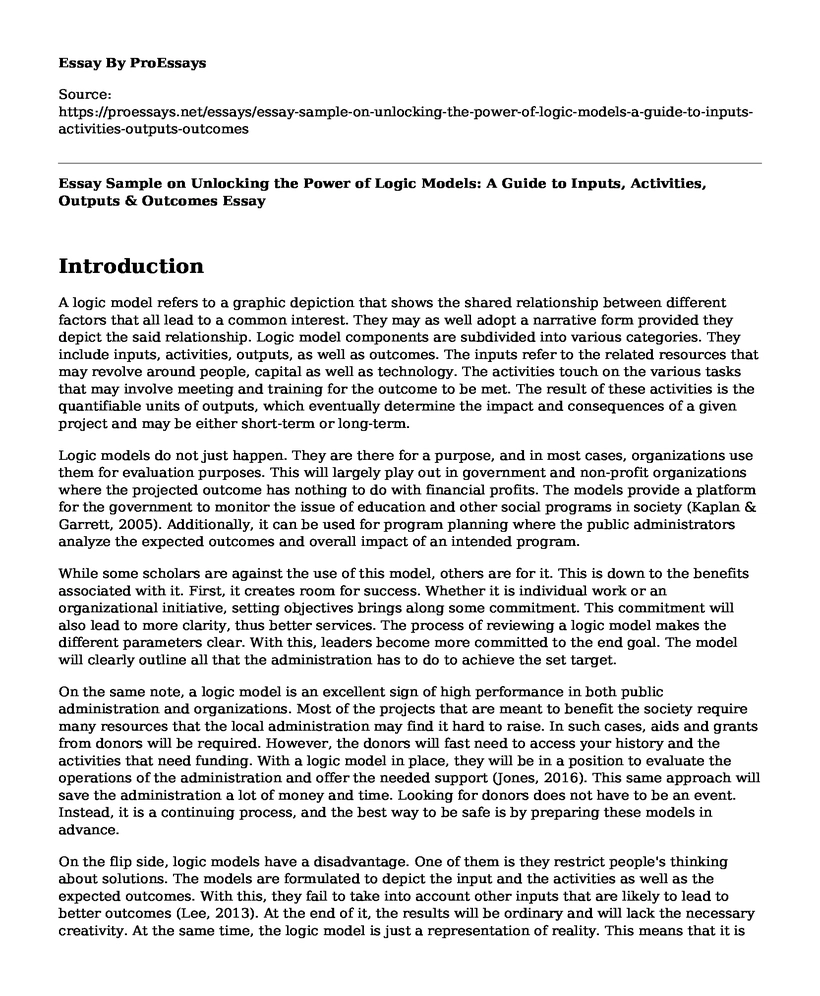Introduction
A logic model refers to a graphic depiction that shows the shared relationship between different factors that all lead to a common interest. They may as well adopt a narrative form provided they depict the said relationship. Logic model components are subdivided into various categories. They include inputs, activities, outputs, as well as outcomes. The inputs refer to the related resources that may revolve around people, capital as well as technology. The activities touch on the various tasks that may involve meeting and training for the outcome to be met. The result of these activities is the quantifiable units of outputs, which eventually determine the impact and consequences of a given project and may be either short-term or long-term.
Logic models do not just happen. They are there for a purpose, and in most cases, organizations use them for evaluation purposes. This will largely play out in government and non-profit organizations where the projected outcome has nothing to do with financial profits. The models provide a platform for the government to monitor the issue of education and other social programs in society (Kaplan & Garrett, 2005). Additionally, it can be used for program planning where the public administrators analyze the expected outcomes and overall impact of an intended program.
While some scholars are against the use of this model, others are for it. This is down to the benefits associated with it. First, it creates room for success. Whether it is individual work or an organizational initiative, setting objectives brings along some commitment. This commitment will also lead to more clarity, thus better services. The process of reviewing a logic model makes the different parameters clear. With this, leaders become more committed to the end goal. The model will clearly outline all that the administration has to do to achieve the set target.
On the same note, a logic model is an excellent sign of high performance in both public administration and organizations. Most of the projects that are meant to benefit the society require many resources that the local administration may find it hard to raise. In such cases, aids and grants from donors will be required. However, the donors will fast need to access your history and the activities that need funding. With a logic model in place, they will be in a position to evaluate the operations of the administration and offer the needed support (Jones, 2016). This same approach will save the administration a lot of money and time. Looking for donors does not have to be an event. Instead, it is a continuing process, and the best way to be safe is by preparing these models in advance.
On the flip side, logic models have a disadvantage. One of them is they restrict people's thinking about solutions. The models are formulated to depict the input and the activities as well as the expected outcomes. With this, they fail to take into account other inputs that are likely to lead to better outcomes (Lee, 2013). At the end of it, the results will be ordinary and will lack the necessary creativity. At the same time, the logic model is just a representation of reality. This means that it is not reality. It is also more focused on the outcomes and ignores other aspects that lead to these outcomes.
A logic model is a graphical or narrative representation meant to depict the outcomes of a given project. It also takes into account issues of input, activities, and output. The models can be used for planning as well as evaluate existing programs. The use of logic models has advantages and disadvantages. Issues of limiting thinking and that of being just a representation of the reality make it less accessible. However, the positive side of it beats the negative since it can be used to lure donors, measure success as well as save time for other operations.
References
Jones, S. C. (2016, January 11). Five reasons your organization needs a logic model. Measurement Resources. https://measurementresourcesco.com/2016/01/11/five-reasons-your-organization-needs-a-logic-model/
Kaplan, S. A., & Garrett, K. E. (2005). The use of logic models by community-based initiatives. Evaluation and program planning, 28(2), 167-172. http://citeseerx.ist.psu.edu/viewdoc/download?doi=10.1.1.597.7489&rep=rep1&type=pdf
Lee, P. L. (2013, March). What is wrong with logic models? LCSA. https://1r65612jvqxn8fcup46pve6b-wpengine.netdna-ssl.com/wp-content/uploads/2013/03/Whats-wrong-with-logic-models.pdf
Cite this page
Essay Sample on Unlocking the Power of Logic Models: A Guide to Inputs, Activities, Outputs & Outcomes. (2023, Apr 24). Retrieved from https://proessays.net/essays/essay-sample-on-unlocking-the-power-of-logic-models-a-guide-to-inputs-activities-outputs-outcomes
If you are the original author of this essay and no longer wish to have it published on the ProEssays website, please click below to request its removal:
- Information Security Management Paper Example
- Difference Between Motivating People Versus Controlling and Problem-Solving
- Paper Example on Creating an Effective Security Plan Using an Enterprise Architecture
- Research Proposal on Strategic Planning, Innovation & Change: Keys to Business Success
- Essay on Organizational Culture & Change Mgmt: A Structured Approach to Transitions
- Essay on Growth Strategy: Conagra Brands' Acquisition of Cranswick Plc's Subsidiary
- Essay Sample on Leadership in Healthcare: Ensuring Quality Care in a Changing Environment







